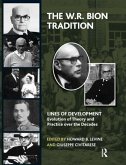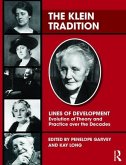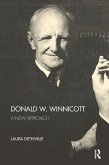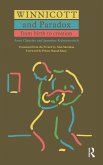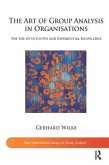The Winnicott Tradition
Lines of Development-Evolution of Theory and Practice Over the Decades
Herausgeber: Spelman, Margaret Boyle; Thomson-Salo, Frances
The Winnicott Tradition
Lines of Development-Evolution of Theory and Practice Over the Decades
Herausgeber: Spelman, Margaret Boyle; Thomson-Salo, Frances
- Broschiertes Buch
- Merkliste
- Auf die Merkliste
- Bewerten Bewerten
- Teilen
- Produkt teilen
- Produkterinnerung
- Produkterinnerung
This book includes articles that describe how Winnicott's thinking facilitates the building of bridges between the internal and external realities, and, outside the boundaries of psychoanalysis as well as within it, between different schools of thought.
Andere Kunden interessierten sich auch für
![The W.R. Bion Tradition The W.R. Bion Tradition]() The W.R. Bion Tradition93,99 €
The W.R. Bion Tradition93,99 €![The Klein Tradition The Klein Tradition]() The Klein Tradition95,99 €
The Klein Tradition95,99 €![Ruthless Winnicott Ruthless Winnicott]() Sally SwartzRuthless Winnicott52,99 €
Sally SwartzRuthless Winnicott52,99 €![Donald W. Winnicott Donald W. Winnicott]() Laura DethivilleDonald W. Winnicott45,99 €
Laura DethivilleDonald W. Winnicott45,99 €![Winnicott Paradox Winnicott Paradox]() Anne ClancierWinnicott Paradox29,99 €
Anne ClancierWinnicott Paradox29,99 €![The Art of Group Analysis in Organisations The Art of Group Analysis in Organisations]() Gerhard WilkeThe Art of Group Analysis in Organisations44,99 €
Gerhard WilkeThe Art of Group Analysis in Organisations44,99 €![The Stuff of Dreams The Stuff of Dreams]() Kirsty HallThe Stuff of Dreams45,99 €
Kirsty HallThe Stuff of Dreams45,99 €-
-
-
This book includes articles that describe how Winnicott's thinking facilitates the building of bridges between the internal and external realities, and, outside the boundaries of psychoanalysis as well as within it, between different schools of thought.
Produktdetails
- Produktdetails
- Verlag: Taylor & Francis
- Seitenzahl: 430
- Erscheinungstermin: 5. November 2014
- Englisch
- Abmessung: 244mm x 188mm x 25mm
- Gewicht: 771g
- ISBN-13: 9781782200079
- ISBN-10: 178220007X
- Artikelnr.: 41620038
- Herstellerkennzeichnung
- Libri GmbH
- Europaallee 1
- 36244 Bad Hersfeld
- gpsr@libri.de
- Verlag: Taylor & Francis
- Seitenzahl: 430
- Erscheinungstermin: 5. November 2014
- Englisch
- Abmessung: 244mm x 188mm x 25mm
- Gewicht: 771g
- ISBN-13: 9781782200079
- ISBN-10: 178220007X
- Artikelnr.: 41620038
- Herstellerkennzeichnung
- Libri GmbH
- Europaallee 1
- 36244 Bad Hersfeld
- gpsr@libri.de
Margaret Boyle Spelman, Frances Thomson-Salo
Series Editors' Foreword
Introduction
Winnicott: His Work and Legacy
Section Introduction
Has Winnicott become a Winnicottian?
Winnicott's constant search for the life that feels real
"People who think in pictures": the continuing dialogue between Marion Milner and Donald Winnicott in Bothered by Alligators
Unassimilated aggression and the emergence of the unit self: Winnicott, Jung, and Matte Blanco
Winnicott and Bion: claiming alternate legacies
Winnicott's anni horribiles: the biographical roots of "Hate in the counter
transference"
Between Winnicott and Lacan
A measure of agreement: an exploration of the relationship of Winnicott and Phyllis Greenacre
Clinical Work and Applications of Winnicott's Tradition
Section Introduction
On potential space
Creating connections
The paternal function in Winnicott: the psychoanalytical frame, becoming human
"Where we start from": thinking with Winnicott and Lacan about the care of homeless adults
Seeing and being seen: the psychodynamics of pornography through the lens of Winnicott's thought
The isolate and the stranger: Winnicott's model of subjectivity and its implications for theory and technique
Hatred and helping: working with our own fear and narcissistic rage
"I feel that you are introducing a big problem. I never became human. I have missed it"
The analyst's oscillating between interpreting and not interpreting: a peculiar Winnicottian point of view on interpreting and not interpreting
Maternal perinatal mental illness: the baby's unexperienced breakdown
Mind the gap: dysynchrony in the writings of Winnicott and associated clinical thoughts
Specialised Work in the Winnicott Tradition
Section Introduction
The importance of being seen: Winnicott, dance movement psychotherapy, and the embodied experience
The location of authenticity
Transitional/transitive
pictures from an exhibition
The seriousness of playfulness
Maternal form in artistic creation
Ways of being: transitional objects and the work of art
Unintegrated states and the process of integration: a new formulation
The reflected self
"Oedipus, schmedipus: so long as he loves his mother": teaching Winnicott to a non
analytic audience
Personal and Theoretical Reflections from Clinicians
Section Introduction
Two pioneers in the history of infant mental health: Winnicott and Bowlby
Winnicott's influence on paediatrics then and now
Anna Freud and Winnicott: developmental stages, aggression, and infantile sexuality
A personal reflection: claiming alternate legacies
Introduction
Winnicott: His Work and Legacy
Section Introduction
Has Winnicott become a Winnicottian?
Winnicott's constant search for the life that feels real
"People who think in pictures": the continuing dialogue between Marion Milner and Donald Winnicott in Bothered by Alligators
Unassimilated aggression and the emergence of the unit self: Winnicott, Jung, and Matte Blanco
Winnicott and Bion: claiming alternate legacies
Winnicott's anni horribiles: the biographical roots of "Hate in the counter
transference"
Between Winnicott and Lacan
A measure of agreement: an exploration of the relationship of Winnicott and Phyllis Greenacre
Clinical Work and Applications of Winnicott's Tradition
Section Introduction
On potential space
Creating connections
The paternal function in Winnicott: the psychoanalytical frame, becoming human
"Where we start from": thinking with Winnicott and Lacan about the care of homeless adults
Seeing and being seen: the psychodynamics of pornography through the lens of Winnicott's thought
The isolate and the stranger: Winnicott's model of subjectivity and its implications for theory and technique
Hatred and helping: working with our own fear and narcissistic rage
"I feel that you are introducing a big problem. I never became human. I have missed it"
The analyst's oscillating between interpreting and not interpreting: a peculiar Winnicottian point of view on interpreting and not interpreting
Maternal perinatal mental illness: the baby's unexperienced breakdown
Mind the gap: dysynchrony in the writings of Winnicott and associated clinical thoughts
Specialised Work in the Winnicott Tradition
Section Introduction
The importance of being seen: Winnicott, dance movement psychotherapy, and the embodied experience
The location of authenticity
Transitional/transitive
pictures from an exhibition
The seriousness of playfulness
Maternal form in artistic creation
Ways of being: transitional objects and the work of art
Unintegrated states and the process of integration: a new formulation
The reflected self
"Oedipus, schmedipus: so long as he loves his mother": teaching Winnicott to a non
analytic audience
Personal and Theoretical Reflections from Clinicians
Section Introduction
Two pioneers in the history of infant mental health: Winnicott and Bowlby
Winnicott's influence on paediatrics then and now
Anna Freud and Winnicott: developmental stages, aggression, and infantile sexuality
A personal reflection: claiming alternate legacies
Series Editors' Foreword
Introduction
Winnicott: His Work and Legacy
Section Introduction
Has Winnicott become a Winnicottian?
Winnicott's constant search for the life that feels real
"People who think in pictures": the continuing dialogue between Marion Milner and Donald Winnicott in Bothered by Alligators
Unassimilated aggression and the emergence of the unit self: Winnicott, Jung, and Matte Blanco
Winnicott and Bion: claiming alternate legacies
Winnicott's anni horribiles: the biographical roots of "Hate in the counter
transference"
Between Winnicott and Lacan
A measure of agreement: an exploration of the relationship of Winnicott and Phyllis Greenacre
Clinical Work and Applications of Winnicott's Tradition
Section Introduction
On potential space
Creating connections
The paternal function in Winnicott: the psychoanalytical frame, becoming human
"Where we start from": thinking with Winnicott and Lacan about the care of homeless adults
Seeing and being seen: the psychodynamics of pornography through the lens of Winnicott's thought
The isolate and the stranger: Winnicott's model of subjectivity and its implications for theory and technique
Hatred and helping: working with our own fear and narcissistic rage
"I feel that you are introducing a big problem. I never became human. I have missed it"
The analyst's oscillating between interpreting and not interpreting: a peculiar Winnicottian point of view on interpreting and not interpreting
Maternal perinatal mental illness: the baby's unexperienced breakdown
Mind the gap: dysynchrony in the writings of Winnicott and associated clinical thoughts
Specialised Work in the Winnicott Tradition
Section Introduction
The importance of being seen: Winnicott, dance movement psychotherapy, and the embodied experience
The location of authenticity
Transitional/transitive
pictures from an exhibition
The seriousness of playfulness
Maternal form in artistic creation
Ways of being: transitional objects and the work of art
Unintegrated states and the process of integration: a new formulation
The reflected self
"Oedipus, schmedipus: so long as he loves his mother": teaching Winnicott to a non
analytic audience
Personal and Theoretical Reflections from Clinicians
Section Introduction
Two pioneers in the history of infant mental health: Winnicott and Bowlby
Winnicott's influence on paediatrics then and now
Anna Freud and Winnicott: developmental stages, aggression, and infantile sexuality
A personal reflection: claiming alternate legacies
Introduction
Winnicott: His Work and Legacy
Section Introduction
Has Winnicott become a Winnicottian?
Winnicott's constant search for the life that feels real
"People who think in pictures": the continuing dialogue between Marion Milner and Donald Winnicott in Bothered by Alligators
Unassimilated aggression and the emergence of the unit self: Winnicott, Jung, and Matte Blanco
Winnicott and Bion: claiming alternate legacies
Winnicott's anni horribiles: the biographical roots of "Hate in the counter
transference"
Between Winnicott and Lacan
A measure of agreement: an exploration of the relationship of Winnicott and Phyllis Greenacre
Clinical Work and Applications of Winnicott's Tradition
Section Introduction
On potential space
Creating connections
The paternal function in Winnicott: the psychoanalytical frame, becoming human
"Where we start from": thinking with Winnicott and Lacan about the care of homeless adults
Seeing and being seen: the psychodynamics of pornography through the lens of Winnicott's thought
The isolate and the stranger: Winnicott's model of subjectivity and its implications for theory and technique
Hatred and helping: working with our own fear and narcissistic rage
"I feel that you are introducing a big problem. I never became human. I have missed it"
The analyst's oscillating between interpreting and not interpreting: a peculiar Winnicottian point of view on interpreting and not interpreting
Maternal perinatal mental illness: the baby's unexperienced breakdown
Mind the gap: dysynchrony in the writings of Winnicott and associated clinical thoughts
Specialised Work in the Winnicott Tradition
Section Introduction
The importance of being seen: Winnicott, dance movement psychotherapy, and the embodied experience
The location of authenticity
Transitional/transitive
pictures from an exhibition
The seriousness of playfulness
Maternal form in artistic creation
Ways of being: transitional objects and the work of art
Unintegrated states and the process of integration: a new formulation
The reflected self
"Oedipus, schmedipus: so long as he loves his mother": teaching Winnicott to a non
analytic audience
Personal and Theoretical Reflections from Clinicians
Section Introduction
Two pioneers in the history of infant mental health: Winnicott and Bowlby
Winnicott's influence on paediatrics then and now
Anna Freud and Winnicott: developmental stages, aggression, and infantile sexuality
A personal reflection: claiming alternate legacies


